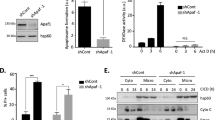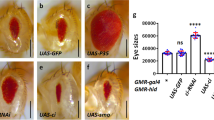Abstract
EGR2 plays a key role in the PTEN-induced apoptotic pathway. Using adenovirus-mediated gene transfer to 39 cancer cell lines, we found that EGR2 could induce apoptosis in a large proportion of these lines by altering the permeability of mitochondrial membranes, releasing cytochrome c and activating caspase-3, -8, and -9. Analysis by cDNA microarray and subsequent functional studies revealed that EGR2 directly transactivates expression of BNIP3L and BAK. Our results helped to clarify the molecular mechanism of the apoptotic pathway induced by PTEN-EGR2, and suggested that EGR2 may be an excellent target molecule for gene therapy to treat a variety of cancers.
This is a preview of subscription content, access via your institution
Access options
Subscribe to this journal
Receive 50 print issues and online access
$259.00 per year
only $5.18 per issue
Buy this article
- Purchase on Springer Link
- Instant access to full article PDF
Prices may be subject to local taxes which are calculated during checkout






Similar content being viewed by others
References
Ashkenazi A and Dixit VM . (1999). Curr. Opin. Cell Biol., 11, 255–260.
Baker SJ and Reddy EP . (1998). Oncogene, 17, 3261–3270.
Chavrier P, Vesque C, Galliot B, Vigneron M, Dolle P, Duboule D and Charnay P . (1990). EMBO J., 9, 1209–1218.
Chavrier P, Zerial M, Lemaire P, Almendral J, Bravo R and Charnay P . (1988). EMBO J., 7, 29–35.
Chen G, Cizeau J, Vande Velde C, Park JH, Bozek G, Bolton J, Shi L, Dubik D and Greenberg A . (1999). J. Biol. Chem., 274, 7–10.
Chittenden T, Harrington EA, O'Connor R, Flemington C, Lutz RJ, Evan GI and Guild BC . (1995). Nature, 374, 733–736.
Farrow SN, White JH, Martinou I, Raven T, Pun KT, Grinham CJ, Martinou JC and Brown R . (1995). Nature, 374, 731–733.
Holland PM, Abramson RD, Watson R and Gelfand DH . (1991). Proc. Natl. Acad. Sci. USA, 88, 7276–7280.
Imazu T, Shimizu S, Tagami S, Matsushima M, Nakamura Y, Miki T, Okuyama A and Tsujimoto Y . (1999). Oncogene, 18, 4523–4529.
Kiefer MC, Brauer MJ, Powers VC, Wu JJ, Umansky SR, Tomei LD and Barr PJ . (1995). Nature, 374, 736–739.
Kruidering M and Evan GI . (2000). IUBMB Life, 50, 85–90.
Li P, Nijhawan D, Budihardjo I, Srinivasula SM, Ahmad M, Alnemri ES and Wang X . (1997a). Cell, 91, 479–489.
Li J, Yen C, Liaw D, Podsypanina K, Bose S, Wang SI, Puc J, Miliaresis C, Rodgers L, McCombie R, Bigner SH, Giovanella BC, Ittmann M, Tycko B, Hibshoosh H, Wigler MH and Parsons R . (1997b). Science, 275, 1943–1947.
MacEwan DJ . (1996). FEBS Lett., 379, 77–81.
Matsushima M, Fujiwara T, Takahashi E, Minaguchi T, Eguchi Y, Tsujimoto Y, Suzumori K and Nakamura Y . (1998). Genes Chromosomes Cancer, 21, 230–235.
Matsushima-Nishiu M, Unoki M, Ono K, Tsunoda T, Minaguchi T, Kuramoto H, Nishida M, Satoh T, Tanaka T and Nakamura Y . (2001). Cancer Res., 61, 3741–3749.
Minaguchi T, Mori T, Kanamori Y, Matsushima M, Yoshikawa H, Taketani Y and Nakamura Y . (1999). Cancer Res., 59, 6063–6067.
Mittelstadt PR and Ashwell JD . (1999). J Biol Chem., 274, 3222–3227.
Miyashita T, Krajewski S, Krajewska M, Wang HG, Lin HK, Liebermann DA, Hoffman B and Reed JC . (1994). Oncogene, 9, 1799–1805.
Nardelli J, Gibson TJ, Vesque C and Charnay P . (1991). Nature, 349, 175–178.
Obata K, Morland SJ, Watson RH, Hitchcock A, Chenevix-Trench G, Thomas EJ and Campbell IG . (1998). Cancer Res., 58, 2095–2097.
Ono K, Tanaka T, Tsunoda T, Kitahara O, Kihara C, Okamoto A, Ochiai K, Takagi T and Nakamura Y . (2000). Cancer Res., 60, 5007–5011.
Rabizadeh S, Oh J, Zhong LT, Yang J, Bitler CM, Butcher LL and Bredesen DE . (1993). Science, 261, 345–348.
Risinger JI, Hayes AK, Berchuck A and Barrett JC . (1997). Cancer Res., 57, 4736–4738.
Satoh S, Daigo Y, Furukawa Y, Kato T, Miwa N, Nishiwaki T, Kawasoe T, Ishiguro H, Fujita M, Tokino T, Sasaki Y, Imaoka S, Murata M, Shimano T, Yamaoka Y and Nakamura Y . (2000). Nat. Genet., 24, 245–250.
Sattler M, Liang H, Nettesheim D, Meadows RP, Harlan JE, Eberstadt M, Yoon HS, Shuker SB, Chang BS, Minn AJ, Thompson CB and Fesik SW . (1997). Science, 275, 983–986.
Sham MH, Vesque C, Nonchev S, Marshall H, Frain M, Gupta RD, Whiting J, Wilkinson D, Charnay P and Krumlauf R . (1993). Cell, 72, 183–196.
Shimizu S, Narita M and Tsujimoto Y . (1999). Nature, 399, 411–412.
Steck PA, Pershouse MA, Jasser SA, Yung WK, Lin H, Ligon AH, Langford LA, Baumgard ML, Hattier T, Davis T, Frye C, Hu R, Swedlund B, Teng DH and Tavtigian SV . (1997). Nat. Genet., 15, 356–362.
Suzuki A, de la Pompa JL, Stambolic V, Elia AJ, Sasaki T, del Barco Barrantes I, Ho A, Wakeham A, Itie A, Khoo W, Fukumoto M and Mak TW . (1998). Curr. Biol., 8, 1169–1178.
Topilko P, Schneider-Maunoury S, Levi G, Baron-Van Evercooren A, Chennoufi AB, Seitanidou T, Babinet C and Charnay P . (1994). Nature, 371, 796–799.
Unoki M and Nakamura Y . (2001). Oncogene, 20, 4457–4465.
Warner LE, Mancias P, Butler IJ, McDonald CM, Keppen L, Koob KG and Lupski JR . (1998). Nat. Genet., 18, 382–384.
Wei MC, Lindsten T, Mootha VK, Weiler S, Gross A, Ashiya M, Thompson CB and Korsmeyer SJ . (2000). Genes Dev., 14, 2060–2071.
Yang E, Zha J, Jockel J, Boise LH, Thompson CB and Korsmeyer SJ . (1995). Cell, 80, 285–291.
Zorick TS, Syroid DE, Arroyo E, Scherer SS and Lemke G . (1996). Mol. Cell Neurosci., 8, 129–145.
Acknowledgements
We thank Hiroyuki Kuramoto (Kitasato University, Sagamihara, Japan), Masato Nishida (Kasumigaura National Hospital, Tsuchiura, Japan), Toyomi Satoh (University of Tsukuba, Tsukuba, Japan), and Isamu Ishiwata (Ishiwata Obstetrics and Gynecologie Hospital, Mito, Japan) for their help in obtaining endometrial cancer cell lines, and Yoichi Furukawa (The University of Tokyo, Tokyo, Japan), Takashi Shimokawa (The University of Tokyo) and Yumi Nakajima (Oncotherapy, Tokyo, Japan) for their helpful advice and discussion. This work was supported in part by Research for the Future Program Grant #00L01402 from the Japan Society for the Promotion of Science (JSPS), and the Research Fellowship of JSPS for Young Scientists.
Author information
Authors and Affiliations
Corresponding author
Rights and permissions
About this article
Cite this article
Unoki, M., Nakamura, Y. EGR2 induces apoptosis in various cancer cell lines by direct transactivation of BNIP3L and BAK. Oncogene 22, 2172–2185 (2003). https://doi.org/10.1038/sj.onc.1206222
Received:
Revised:
Accepted:
Published:
Issue Date:
DOI: https://doi.org/10.1038/sj.onc.1206222
Keywords
This article is cited by
-
EGR2 is a hub-gene in myocardial infarction and aggravates inflammation and apoptosis in hypoxia-induced cardiomyocytes
BMC Cardiovascular Disorders (2022)
-
Integrative network-based approaches identified systems-level molecular signatures associated with gallbladder cancer pathogenesis from gallstone diseases
Journal of Biosciences (2022)
-
EGR1/2 Inhibits Papillary Thyroid Carcinoma Cell Growth by Suppressing the Expression of PTEN and BAX
Biochemical Genetics (2021)
-
Detecting qualitative changes in biological systems
Scientific Reports (2020)
-
Cyclooxygenase (COX) Inhibition by Acetyl Salicylic Acid (ASA) Enhances Antitumor Effects of Nitric Oxide in Glioblastoma In Vitro
Molecular Neurobiology (2019)



